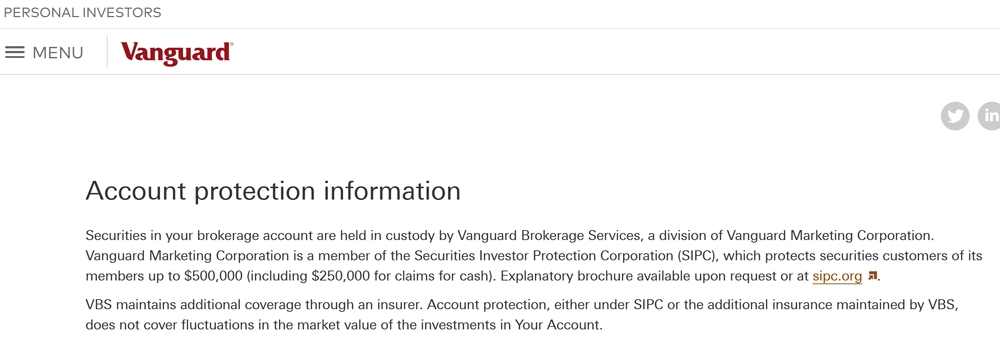Is Vanguard FDIC Insured?
Vanguard has SIPC insurance but it doesn’t have FDIC insurance. Here are the details:
Vanguard only offers brokerage accounts. It does not have any bank accounts, like checking or savings accounts.
The FDIC only guarantees bank accounts, so there is no FDIC insurance at Vanguard.
Every brokerage account at Vanguard is protected by SIPC. The insurance limit is $500,000. Up to $250,000 of this maximum can be applied to idle cash.

Calculating SIPC Coverage at Vanguard
SIPC insurance generally is per customer, per brokerage firm. This means you can double up by having multiple accounts at multiple brokerage firms, but not multiple accounts at a single firm. This rule itself has exceptions, though.
For example, under SIPC rules, IRAs have their own insurance that is separate from taxable accounts. And Roth IRAs are separate from Traditional IRAs.
If you have 2 IRAs at Vanguard (one Roth and one Traditional) and 2 taxable individual accounts, you would have a total of $1.5 million of insurance. The retirement accounts would have a total of $1 million of protection ($500,000 for the Roth, and another $500,000 for the Traditional), and the taxable accounts would have another $500,000 (but not $500,000 for each).
But if one of the taxable accounts is a joint account, it would have its own $500,000 limit, which would produce $1 million in total insurance for the taxable accounts.
Vanguard And Top Competitors
Money Market Settlement Fund
Vanguard uses a money market mutual fund as the core position for every brokerage account. Thus, a free cash balance in an account will be automatically swept into a money market fund. Vanguard calls this fund the settlement fund.
Because the settlement fund is considered a security, it receives $500,000 worth of SIPC protection instead of $250,000. It is not considered cash, although it is a cash equivalent, and the fund’s NAV stays exactly at $1.00 under normal circumstances.
Currently, Vanguard’s Federal Money Market Fund is the only settlement fund available to serve as a brokerage account’s cash position.
Account Example
To illustrate how SIPC protection works at Vanguard, suppose you have a taxable brokerage account with $600,000 of assets. The portfolio is broken down as follows:
$230,000 in Tesla stock
$70,000 in GLD, the gold ETF
$300,000 in VMFXX, the settlement fund
In the very unlikely event that Vanguard filed for bankruptcy and account positions were missing, the entire account would not be guaranteed by SIPC. Only 83.3% of the account would be protected ($500k/$600k). The entire settlement fund, not just $250,000, could be defended, but $100,000 of the account value would be left unprotected, at least by SIPC.
Remember that the assets in the account legally belong to the account holder, not to Vanguard, so if Vanguard did ever file for bankruptcy, creditors could not claim the assets. SIPC insurance is there in case positions ever go missing. In the securities world, this does happen from time to time.
Supplemental Insurance at Vanguard
Vanguard does have an auxiliary insurance policy through Lloyd’s of London and London Company Insurers. It adds a second layer of protection to a brokerage account if, and only if, SIPC protection is exhausted.
The secondary insurance policy is good for up to $49.5 million per account. There is an aggregate maximum of $250 million. That means the insurance policy will shell out a quarter of a billion dollars at most across all accounts that have maxed out SIPC coverage.
Going back to our example, the $100,000 of account value that is unprotected now should be protected by the supplemental insurance policy, assuming the aggregate limit is not exhausted. After that point, there are no guarantees.
Charles Schwab vs Vanguard: IRA Account Types
Vanguard clients can choose from a variety of IRAs. The firm offers Roth, Traditional, Inherited, Rollover, SEP, and SIMPLE
accounts. Customers at Charles Schwab also have a selection of IRA’s to choose from. The broker offers Traditional, Roth, SEP, SIMPLE, Custodial, Inherited, and Rollover accounts.
IRA Fees and Minimums
Vanguard charges a $20 annual fee for IRAs. There is also a $20 charge for each Vanguard mutual fund if it has a balance under $10,000. These fees can be waived by signing up for electronic delivery of account communications. Accounts with high balances (defined as $50,000 or above) are automatically exempt from both fees. A SIMPLE IRA at Vanguard has a $25 annual fee for each Vanguard fund in the account. The fee is waived for accounts with $50,000 or more in assets. A Vanguard IRA has no minimum opening deposit requirement.
Schwab IRAs are fee-free. This means they have no annual fee, no setup fee, and no inactivity fee.
The broker does require a minimum initial deposit for all IRAs.
Mutual Funds
Vanguard clients can trade more than 16,000 mutual funds. A large selection of these funds carry no load and no transaction fee. Mutual funds with a transaction fee are $35 in a small account. Customers with a large account balance ($50,000 and above) are charged a lower transaction fee.
Investors at Schwab can buy and sell more than 6,000 mutual funds. Over 4,200 of these are OneSource funds. This list has no-load and no-transaction-fee funds. Mutual funds with Schwab that do come with a transaction fee are a somewhat steep $49.95 to purchase, although there is no fee on the sell side.
IRA Calculators and Tools
Schwab clients have access to some handy calculators. One, for instance, determines if withdrawals from an IRA are required to be taken according to IRS guidelines. Investors with Schwab can also use a tool to evaluate a possible IRA conversion.
Investors will find a good selection of retirement calculators at Vanguard. The broker has ten calculators, more than Schwab has. The Vanguard calculators help evaluate issues such as required minimum distributions from an IRA and how much to save for retirement.

IRA Videos and Learning Materials
Vanguard has articles on its website that discuss retirement issues. These documents cover several important topics that retirees will find important, such as investing in funds that pay monthly income.

The Schwab website has a nice collection of videos covering IRAs and other retirement topics. These resources discuss some important issues, such as how to transition from a 401(k) to a Roth IRA, and how to use an IRA for estate planning purposes.
Free Charles Schwab IRA
Get $0 commissions + satisfaction guarantee at Charles Schwab.
Open Schwab Account
Find a Financial Advisor
If you are looking for a professional money management service in your area, you can
find a Financial Advisor on the Wiser Advisor.
Try Wiser Advisor
Updated on 1/19/2024.
|